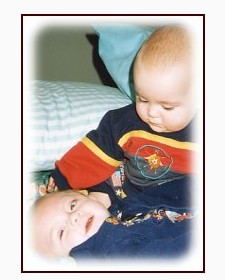Robert’s Road to Recovery
Back to the Beginning
 Robert and his twin older brother, Matt were induced at 37 weeks because Robert had stopped growing two weeks before. The twins are in-vitro babies that started out as triplets. They have three older half-siblings, Marie (11 years old), Allyssa (9) and Nick (9).
Robert and his twin older brother, Matt were induced at 37 weeks because Robert had stopped growing two weeks before. The twins are in-vitro babies that started out as triplets. They have three older half-siblings, Marie (11 years old), Allyssa (9) and Nick (9).
Matt weighed 5 pounds at birth and Robert weighed 4 pd. 4 oz. Robert was taken to the NICU, due to small size and respiratory distress. Robert was slightly tachypneic (whatever that is) until they performed a partial volume exchange transfusion. His hematocrit was slightly elevated. Robert was consistently hypoglycemic prior to feedings and had some poor feedings with gagging and regurgitation. Robert also underwent Algo hearing screening test prior to discharge. Lucile Packard Children’s Hospital recommended we get Robert screened again.
Matt weighed 5 pounds at birth and Robert weighed 4 pd. 4 oz. Robert was taken to the NICU, due to small size and respiratory distress. Robert was slightly tachypneic (whatever that is) until they performed a partial volume exchange transfusion. His hematocrit was slightly elevated. Robert was consistently hypoglycemic prior to feedings and had some poor feedings with gagging and regurgitation. Robert also underwent Algo hearing screening test prior to discharge. Lucile Packard Children’s Hospital recommended we get Robert screened again.
Once the twins were home, they both seemed like a lot of work and I don’t remember much of the first four months. Mark says Robert threw up a lot but I don’t remember him being much worse than Matt.
Robert had hearing tests that showed he had moderate to severe hearing loss. We could also tell something was different about his head. He had early suture closing. We could also tell, within four months that something was unusual in his back. It felt very different than Matt’s. Our local orthopedic surgeon confirmed that L1 and L2 were not forming right. He wanted to do surgery right away but based on a second opinion, we decided to wait until he was older.
We scheduled Robert’s skull surgery at eight months but on the day of the surgery the anathesialogist did not feel he was healthy enough. Robert had been seeing his pediatrician almost every week of his life. When he was very sick and crackly, the pediatrician would give him a shot of steroids and we would have Robert sleep in his car seat in our bathroom with the shower running hoping the humidity would help him breath.
When Robert’s surgery was cancelled the day it was to occur I decided something needed to be done besides seeing the pediatrician again. I told him we needed to escalate Robert’s problem to a specialist. Two days later we went to see Dr. Fox, an excellent pulmonologist. Dr. Fox diagnosed gastric-intestinal reflux. This was Tuesday and on Wednesday Robert entered the hospital for three very important tests. He had the 24-hour pH probe tests that proved he was refluxing. The issue was not the amount of reflux but how often. Most people reflux 60 times every 24 hours; Robert refluxed 360 times every 24 hours. By Friday Robert had surgery, a fundoplication and pyloroplasty (his stomach didn’t empty quick enough).
It took Robert another 8 months to get healthy enough to have the cranialectomy. He had a plastic surgeon also during the surgery because they usually like to do this surgery before a child is six months. Between February and October, Robert had a couple of trips to the hospital with pneumonia.
In February of 1998, Robert had back surgery on L1 and L2. The surgery went well but when I took him in two weeks later for x-rays, the bone placed between the vertebras had slipped. He had to go into surgery again the next week. This time his surgeon was used someone else’s femur and put Robert in a cast.
His pulmonologist and surgeon probably made a big mistake with his cast. There was no tummy hole in it. Robert developed Adult Respiratory Syndrome. His O2 saturations were down at 62% without oxygen. Robert almost died that week. Dr. Fox put him on an oscillator instead of a ventilator and we believe this saved his life.
Read more:
Back to the Beginning | Suspicions & Diagnosis | An action plan & donor search | Robert’s surgeries
Home | prologue | diary BMT #1 | medical notes BMT #1 | diary BMT #2 | graphs & charts BMT #2 | photo gallery | e-mail Kathleen
